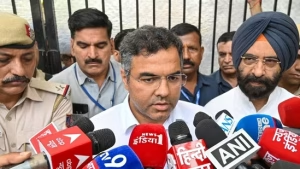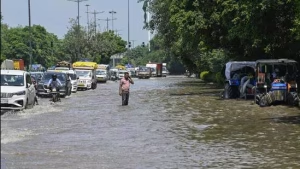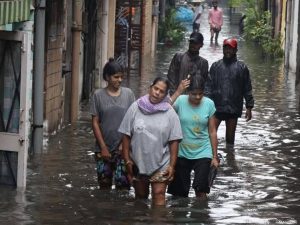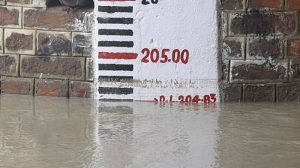New Delhi – Delhi’s Water Minister Parvesh Verma made controversial statements on Friday regarding the Delhi waterlogging situation, claiming that reports of widespread submersion are exaggerated. Speaking from the Civil Lines area, Verma asserted that “there is not a drop of water in the Civil Lines area,” challenging widespread reports of severe flooding across the national capital.
The minister’s remarks come at a time when numerous areas of Delhi are experiencing significant Delhi waterlogging, with Yamuna River water entering residential colonies and affecting thousands of residents. Verma’s statement has sparked debate about the actual extent of the flooding situation and the government’s response to the crisis.
Civil Lines Area Assessment and Claims

During his interaction with reporters in the Civil Lines area, Minister Parvesh Verma specifically addressed the Delhi waterlogging concerns by focusing on local conditions. He emphasized that the service road along the Ring Road, which shows visible waterlogging, is positioned approximately 8 to 10 feet below the main Ring Road level, suggesting that this geographic factor contributes to water accumulation.
Verma clarified that the Delhi waterlogging visible on the service road is not primarily due to Yamuna River overflow but rather results from Thursday’s rainfall. He assured that pumping operations are actively underway to remove the accumulated water from these lower-lying areas, indicating that the situation is being addressed through mechanical interventions.
The minister’s assessment of the Delhi waterlogging situation in Civil Lines included his observation that flooding is limited to specific areas, particularly the service road and temple vicinity, rather than affecting the entire Civil Lines region as some reports suggest.
Disputed Reports and Ground Reality

Minister Verma challenged media representations of the Delhi waterlogging situation, stating that it would be incorrect to claim that entire Delhi is submerged in Yamuna River water. His comments aimed to provide what he described as a more accurate picture of the flooding extent, contrasting with reports suggesting widespread submersion across the capital.
However, the Delhi waterlogging situation presents a complex picture when examining ground reports from affected areas. Residents of Civil Lines’ Bela Road have reported experiencing conditions reminiscent of the 2023 flooding crisis, with water levels reaching 4 to 5 feet in height, significantly impacting daily life and accessibility.
The contradiction between official statements and resident experiences regarding Delhi waterlogging highlights the challenge of accurately assessing and communicating the extent of urban flooding during monsoon seasons.
Affected Areas and Resident Experiences


Despite ministerial claims, several areas near the Yamuna River banks continue experiencing significant Delhi waterlogging, including Civil Lines, Bela Road, Monastery Market, and Yamuna Bazar area. These locations have witnessed varying degrees of flood impact, with some areas completely inundated while others remain relatively unaffected.
Residents of Bela Road specifically reported that the Delhi waterlogging situation mirrors their 2023 experiences, with entire areas submerged under several feet of water. The flooding has created substantial obstacles for residents, blocking doorways and severely disrupting normal activities and movement within affected neighborhoods.
The disparity between official assessments and resident reports of Delhi waterlogging suggests that the flooding impact varies significantly across different micro-locations within the same general area, creating confusion about the overall severity of the situation.
Yamuna River Water Levels and Technical Data


Official monitoring data indicates that Yamuna River water levels have shown slight variations during the current Delhi waterlogging crisis. According to Central Water Commission records, the river’s water level decreased marginally to 207.33 meters by 7 a.m. on Friday, suggesting some improvement in the flooding situation.
However, despite this slight reduction in water levels, several areas continue experiencing Delhi waterlogging effects, with Yamuna water still present in low-lying residential colonies. The persistence of flooding despite decreasing river levels indicates that drainage and water evacuation remain significant challenges.
Government Response and Mitigation Efforts
The Delhi waterlogging situation has prompted various government responses, including the deployment of water pumping systems in affected areas. Minister Verma’s statements indicate that authorities are actively working to remove accumulated water from flooded locations, particularly focusing on service roads and other low-lying areas prone to water accumulation.
The government’s approach to addressing Delhi waterlogging appears to combine immediate relief measures, such as mechanical water removal, with communications aimed at managing public perception of the crisis extent. This dual strategy reflects the complex challenges of urban flood management in a densely populated metropolitan area.
Ongoing Challenges and Future Preparedness
The current Delhi waterlogging situation underscores the persistent vulnerability of the national capital to monsoon flooding, particularly in areas adjacent to the Yamuna River. The recurring nature of such flooding events, as evidenced by references to similar 2023 conditions, suggests that long-term infrastructure solutions remain necessary.
As Delhi continues to grapple with the immediate effects of the current waterlogging crisis, the debate between official assessments and ground reality highlights the need for comprehensive flood management strategies that address both immediate relief and long-term urban planning considerations.

